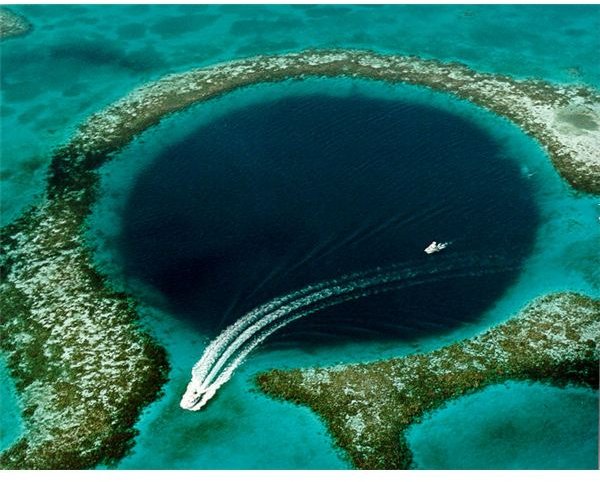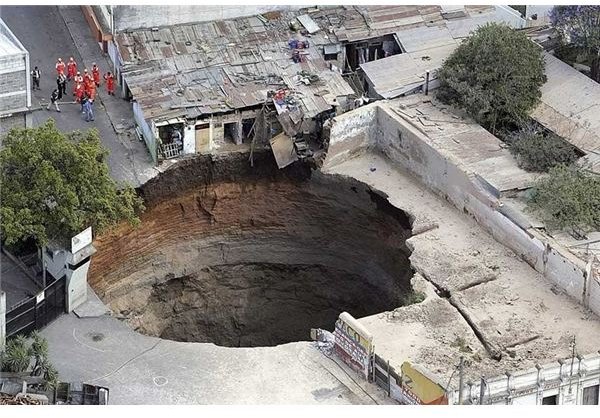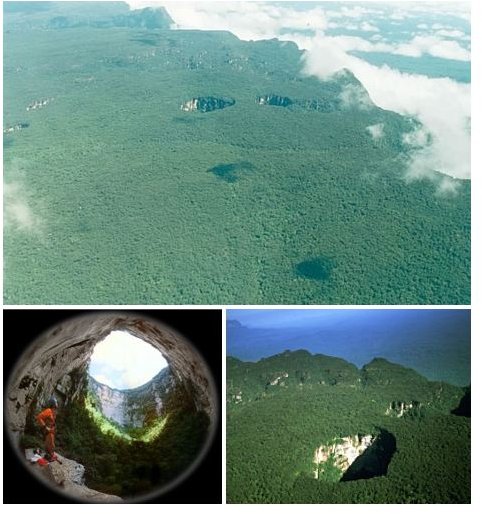What is a Sinkhole? How a Sinkhole Develops and more Sinkhole Facts
A sinkhole is a cave-in or natural depression in the land’s surface caused by the chemical dissolution of carbonate rocks (karst process) or by erosion of rocks or soil below the land’s surface. Commonly of circular shape, sinkholes vary in size. Some are as small as 3.3 feet (1 meter) in diameter and depth; and others are as massive as 980 feet (300 meters) in both diameter and depth. Sinkholes are also known as shake holes, sinks, swallet holes, swallets, cenotes or dolines.
Sinkholes can form anywhere the world. They are not always linked with karst landscapes. A karst landscape is a special type of land formed by the dissolution of soluble rocks like limestone and dolomite. These regions have aquifers – an underground bed of water bearing permeable rocks. The regions that do not have surface streams and all the drainage occurs below the land’s surface are home to hundreds of sinkholes.
Sinkhole Development
Sinkholes may develop slowly or unexpectedly. Typically, sinkholes form naturally due to the erosion of bedrock caused by the flowing or moving water beneath the grounds surface. Sinkholes commonly occur in areas where the rock beneath the land’s surface is carbonate rock, limestone, salt beds or rocks that have the tendency to dissolve with moving underground water. As the rock beneath the land’s surface dissolves, underground caverns and spaces develop. The land’s surface usually remains intact until it loses support. Then, a collapse in the land’s surface gives rise to a sinkhole. Salt beds cause trouble in areas with high saltwater concentration. As the water levels recede from these salt beds, they become vulnerable to erosion from water currents. Such sinkholes are called blue holes when they occur in oceans. Blue holes also form when coral reefs and islands collapse to enormous depths. Blue holes are often popular diving spots.

At times, sinkhole development is human induced, triggered by activities like construction, ground water pumping, and other development practices. Sinkholes also form when man made water diversion systems are developed by altering the natural water drainage patterns. In addition, many sinkholes occur when the land’s surface is changed for industrial or run off storage ponds. The substantial weight of the new material pressurizes the underground supporting material, causing the structure to collapse forming a sinkhole. Moreover, humans have been using sinkholes as waste disposal sites, threatening to pollute underground water resources.
Sinkhole Facts
-
Qattara Depression near Cairo, Egypt is the largest natural sinkhole in the world. Its 80 kilometers (50 miles) long and 120 kilometers (74 miles) wide.
-
Berezniki’s sinkhole in Russia began in 1986 and has been mysteriously growing since then.
-
Human induced sinkhole swallowed a dozen of homes in Guatemala in 2007 and another 60 feet (18 meters) wide and 300 feet (100 meters) deep sinkhole has appeared in Guatemala this year.

-
Sarisarinama tepui in Venezuela is home to the world’s most spectacular and mysterious natural sinkholes.

-
El Zacaton cenote in Mexico is the world’s deepest water-filled sinkhole. It is 318 meters deep.
References
- https://webecoist.com/2008/08/26/incredible-strange-amazing-sinkholes/
- https://ga.water.usgs.gov/edu/earthgwsinkholes.html
- https://science.howstuffworks.com/sinkhole.htm/printable
